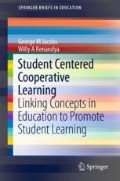Abstract
This chapter reviews findings from neuroscience and discusses how Student Centered Cooperative Learning can facilitate application of these findings on behalf of learning. Firstly, on a physical level, neuroscience tells us that human brains need water and nutrition. Secondly, on an affective level, students need the right level of challenge, support in the face of bullying and other threats, and motivation. Thirdly, insights from neuroscience confirm that cognitive learning benefits when new learning connects with students’ background knowledge in order that students can construct networks of knowledge. Next, that chapter focuses on insights from social neuroscience, in particular why and how to promote mutual concern, encourage students to believe that collaboration can be beneficial, help students develop and deploy cooperative skills, and manifest altruism.
Access this chapter
Tax calculation will be finalised at checkout
Purchases are for personal use only
References
Bartlett, F. C. (1932). Remembering: A study in experimental and social psychology. Cambridge, United Kingdom: Cambridge University Press.
Bower, B. (2013, November 13). Bigger numbers, not better brains smarten human cultures: Tool innovations take off as populations grow and share diverse ideas. ScienceNews. Retrieved from sciencenews.org/article/bigger-numbers-not-better-brains-smarten-human-cultures.
Chng, G. (2015, January 22). To succeed, fail fast and learn quickly. Straits Times. Retrieved from https://www.straitstimes.com/opinion/to-succeed-fail-fast-and-learn-quickly.
Cozolino, L. (2013). The social neuroscience of education: Optimizing attachment & learning in the classroom. New York, NY: W.W. Norton.
Crowther-Heyck, H. (1999). George A. Miller, language, and the computer metaphor and mind. History of Psychology, 2(1), 37–64.
Dunbar, R. (1998). The social brain hypothesis. Evolutionary Anthropology, 6, 178–190.
Falout, J., Murphey, T., Fukuda, T., & Fukada, Y. (2015). Whole-class self-referential feedback from university EFL contexts to the world: Extending the social life of information by looping it forward. The Asia-Pacific Education Researcher, 24(1), 1–10. https://doi.org/10.1007/s40299-015-0227-4
Fox, K. C. R., Andrews-Hanna, J. R., Mills, C., Dixon, M. L., Markovic, J., Thompson, E., et al. (2018). Affective neuroscience of self-generated thought. Annals of the New York Academy of Sciences, 1426(1), 25–51. https://doi.org/10.1111/nyas.13740.
Fry, B. N., & Runyan, J. D. (2018). Teaching empathic concern and altruism in the smartphone age. Journal of Moral Education, 47(1), 1–16. https://doi.org/10.1080/03057240.2017.1374932.
Fuchs, E., & Flugge, G. (2014). Adult neuroplasticity: More than 40 years of research. Neural Plasticity. https://doi.org/10.1155/2014/541870.
Gonzalez, D. H., & Chiviacowsky, S. (2018). Relatedness support enhances motor learning. Psychological Research, 82(3), 439–447.
Greger, M. (2013). Does a drink of water make children smarter? Retrieved from https://nutritionfacts.org/video/does-a-drink-of-water-make-children-smarter/.
Guant, A. (2016, September 15). Talk detectives. Retrieved from https://www.edutopia.org/video/60-second-strategy-talk-detectives?
Hanson, R. (2013). Hardwiring happiness: How to reshape your brain and your life. London, United Kingdom: Rider Books.
Hymel, S., McClure, R., Miller, M., Shumka, E., & Trach, J. (2015). Addressing school bullying: Insights from theories of group processes. Journal of Applied Developmental Psychology, 37, 16–24.
Jan, L. (2017). Neuroscience: Past and future. (2018). Neuron, 98(1), 10–11. doi:http://dx.doi.org.elibrary.jcu.edu.au/10.1016/j.neuron.2018.03.029.
Jensen, E. P. (2005). Teaching with the brain in mind (2nd ed.). Alexandria, VA: Association for Supervision and Curriculum Development.
Jensen, E. P. (2008). A fresh look at brain-based education. Phi Delta Kappan, 89(6), 408–417.
Johnson, D. W., & Johnson, F. P. (2013). Joining together: Group theory and group skills (11th ed.). Boston, MA: Allyn & Bacon.
Johnson, D. W., & Johnson, R. T. (n.d.). An overview of cooperative learning. Retrieved from http://www.co-operation.org/what-is-cooperative-learning.
Johnson, D. W., & Johnson, R. T. (1991). Cooperative learning lesson structures. Edina, MN: Interaction Book Company.
Kumar, L., & Yap, C. K. (2010). Brain-based education: Its pedagogical implications and research relevance. i-Manager’s Journal on Educational Psychology, 4(2), 1–6.
Lam, F. H., Low, C. C., Jacobs, G. M., & Fazilah, M. I. (2004). Letting go: Promoting student-student academic learning outside of class-time. Journal of Student Centered Learning, 2(1), 43–52.
Levin, S. M., Barnard, N. D., & Saltalamacchia, R. E. (2017). A proposal for improvements in the supplemental nutrition assistance program. American Journal of Preventive Medicine, 52(2), S186–S192. https://doi.org/10.1016/j.amepre.2016.07.016.
Lieberman, M. (2013). Social: Why our brains are wired to connect. New York, NY: Crown.
Murphey, T. (2016). Four social neuroscience on-going requisites for effective collaborative learning and the altruistic turn. TESL-EJ, 19(4). Retrieved from http://www.tesl-ej.org/wordpress/issues/volume19/ej76/ej76a4.
Näykki, P., & Järvelä, S. (2008). How pictorial knowledge representations mediate collaborative knowledge construction in groups. Journal of Research on Technology in Education, 40(3), 359–387. https://doi.org/10.1080/15391523.2008.10782512.
Rosenberg, M. B. (2003). Nonviolent communication: A language of life (2nd ed.). Encinitas, CA: Puddle Dancer Press.
Roseth, C. J., Johnson, D. W., & Johnson, R. T. (2008). Promoting early adolescents’ achievement and peer relationships: The effects of cooperative, competitive, and individualistic goal structures. Psychological Bulletin, 134(2), 223–246. http://dx.doi.org.elibrary.jcu.edu.au/10.1037/0033-2909.134.2.223.
Shaughnessy, M. (2016). An interview with Marcia Tate: Formative Assessment and brain based learning. Journal of Education and Learning (EduLearn), 10(3), 203–207.
Stein, M., & Muzzin, M. (2018). Learning from failure. Science and Children, 55(8), 62–65.
Stookey, J. D., Brass, B., Holliday, A., & Arieff, A. (2012). What is the cell hydration status of healthy children in the USA? Preliminary data on urine osmolality and water intake. Public health nutrition, 15(11), 2148–2156.
Swaminathan, N. (2008, April 29). Why does the brain need so much power? Retrieved from https://www.scientificamerican.com/article/why-does-the-brain-need-s/.
Tomasello, M. (2009). Why we cooperate. Cambridge, MA: MIT Press.
Vygotsky, L. S. (1978). Mind in society. In M. Cole, V. John-Steiner, S. Scribner & E. Souberman (Eds). Cambridge, MA: Harvard University Press.
Wentzel, K. R., Barry, C. M., & Caldwell, K. A. (2004). Friendships in middle school: Influences on motivation and school adjustment. Journal of Educational Psychology, 96(2), 195–203. https://doi.org/10.1037/0022-0663.96.2.195.
Willis, J. (2007). Cooperative learning is a brain turn-on. Middle School Journal, 38(4), 4–13.
Author information
Authors and Affiliations
Corresponding author
Rights and permissions
Copyright information
© 2019 The Author(s), under exclusive licence to Springer Nature Singapore Pte Ltd.
About this chapter
Cite this chapter
Jacobs, G.M., Renandya, W.A. (2019). Neuroscience and What It Tells About Education. In: Student Centered Cooperative Learning. SpringerBriefs in Education. Springer, Singapore. https://doi.org/10.1007/978-981-13-7213-1_3
Download citation
DOI: https://doi.org/10.1007/978-981-13-7213-1_3
Published:
Publisher Name: Springer, Singapore
Print ISBN: 978-981-13-7212-4
Online ISBN: 978-981-13-7213-1
eBook Packages: EducationEducation (R0)

